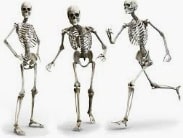In order to fully understand the meaning of the term osteology, it is necessary, first of all, to discover its etymological origin. In this case, it must be indicated that it is a word that derives from Greek. Specifically, it is the result of the sum of the following lexical components of said language:
-The noun “osteon”, which can be translated as “bone”.
-The word “logos”, which is equivalent to “study” or “treaty”.
-The suffix “-ia”, which is used to indicate “quality”.
Osteology is the area of anatomy that is responsible for neither more nor less than the study of bones .
 Before moving forward, it is important to remember that anatomy is the science that is dedicated to the analysis of the shape and structure of living organisms , also taking into account the links established by its various components. The bones , on the other hand, are the pieces that make up the skeleton.
Before moving forward, it is important to remember that anatomy is the science that is dedicated to the analysis of the shape and structure of living organisms , also taking into account the links established by its various components. The bones , on the other hand, are the pieces that make up the skeleton.
Returning to the idea of osteology , whose specialists are known as osteologists , it is a scientific discipline focused on bone elements and the system they make up. Osteology considers the different types of bones and bone tissues and also focuses on their various functions.
According to osteology, bones are divided into irregular, flat, short and long . In a bone it is possible to distinguish between the epiphyses (the ends), the diaphysis (the body) and the metaphysis (the union between the epiphysis and the diaphysis).
However, we cannot ignore that osteology also refers to and studies other different types of bones, such as these:
-Supernumerary bones, which are short and it should be noted that they do not exist in the body of all people.
-The pneumatic bones, which are located in the head and are responsible for relating the middle ear to the airway. They are characterized because their structure is made up of different cavities or hollow formations through which the air entering through the nose circulates.
-The sesamoid bones, which are short and whose main function is to protect a tendon or ligament from excessive friction.
-The accessory bones, for their part, have the particularity that they are located in the skull, specifically in the occipital area. It should be noted that they are a variety within the so-called supernumerary bones.
Regarding the functions of bones, they can assume roles linked to the storage of phosphate and calcium : locomotion; the production of certain blood components; the protection of organs; and the structure of the body.
It should be noted that the set of bones that articulate and link together is called a skeleton . The skeleton, which is the object of study in osteology, provides consistency to the body of human beings and vertebrate animals and protects what are their soft parts.
